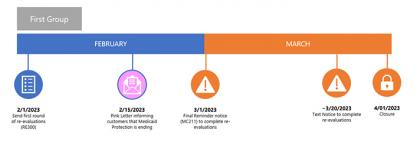Idaho emergency response and mental health professionals gathered last week for a conference focusing on managing crisis in school settings.
Hosted by DHW’s Division of Behavioral Health Feb. 8 and 9 in Garden City, the Idaho Crisis Con featured keynote presentations about calming aggressive and emotionally disturbed individuals, and preventing school shootings.
“That our conference was held just days before the tragic shootings at Michigan State this week underscores the need to talk about and get ahead of this type of tragedy,” said Statewide Crisis Program Manager Belinda Dalrymple, who works in the Division of Behavioral Health. “Our hearts go out to the people of East Lansing and the 67 other communities where mass shootings have also already taken place this year.”
The Idaho Crisis Con brought together professional counselors, administrators, and public servants with emergency first responders including police, fire, EMS, and corrections. Those in attendance represented the entire spectrum of professionals involved with identifying a potential situation before it escalates, and responding to a situation if it does.
“The 260 people who attended Idaho Crisis Con are professionals who someday may be in a situation where they need to use these techniques to protect students, and themselves,” Dalrymple said.
Crises of varying degrees occur every day in schools across Idaho. Students, parents, teachers, and staff may experience stress and anxiety, and crises can arise. The challenge for counselors, police, and school administrators is figuring out how to help a student in crisis and de-escalate a situation before it gets out of control or becomes violent.
“For administrators, it is essential that they know how to respond to warning signs before there is an attack, so they can intervene and perform an effective threat assessment to hopefully avoid having an attack” said keynote speaker Peter Langman, a sought-after expert on the psychology of school shooters and other perpetrators of mass violence.
Threat assessments can help show a pattern of behavior common among school shooters or would-be school shooters, but only if they are thoroughly investigated and shared with appropriate people. Langman cited situations where administrators, police, parents, and children all withheld information, lied, or underestimated the seriousness of a behavioral pattern.
Langman said there are three types of school shooters: psychopathic (no empathy and/or desire power), psychotic (delusions, hallucinations, and/or want to harm others), and traumatized (chaotic/abusive home life, parental substance abuse, or depression). For each profile, violence may manifest in different ways.
In some cases, a heated situation can be quelled before it escalates.
“De-escalation is a specific strategy which is used to try to help people who are in states of agitation or anger,” said keynote speaker Ellis Amdur, a prominent de-escalation trainer in the Pacific Northwest. “We need to clearly delineate what that strategy is and put it in its proper place for professionals to use. If your kid is in a bad mood and you distract your kid, that is a de-escalation strategy.”
Once a person becomes angry, however, verbal de-escalation becomes challenging.
“You can’t problem-solve with an angry person,” Amdur said. “You cannot de-escalate a violent person.”
Amdur said identifying whether a person is calm, angry, or enraged is necessary to determine how to engage them. If they’re calm, discussion may work. If they’re angry, de-escalation techniques may work. If they’re enraged, first responders should exert control to create space.
De-escalation techniques also may vary. The point is to separate a person from their anger, and that may involve giving compliments, asking questions, or talking about food.
While the Idaho Crisis Con covered a wide range of scenarios and responses, the predominant theme was safety: the safety of students, staff, teachers, and first responders. While crisis situations will no-doubt vary, the ways to prevent or de-escalate include advanced communication among all parties, performing proper threat assessments, and training to use de-escalation techniques that may limit or negate violent acts.
The Idaho Crisis Con is envisioned as an annual event that will bring together first responders and mental health professionals to identify and implement solutions for pressing behavioral health issues.
Dustin Lapray has been with the Division of Behavioral Health for two years. He accepted the role of public involvement officer earlier this month.
The Idaho Department of Health and Welfare is dedicated to strengthening the health, safety, and independence of Idahoans. Learn more at healthandwelfare.idaho.gov.



Join the Discussion
Please note the following terms of participation in commenting on the DHW Voice blog.
To ensure a productive discussion you agree to post only comments directly related to this post and to refrain from posting obscenities; threatening, abusive or discriminatory language; sexually explicit material; and other material that would violate the law if published here; promotional content; or private information such as phone numbers or addresses. DHW reserves the right to screen and remove inappropriate comments.